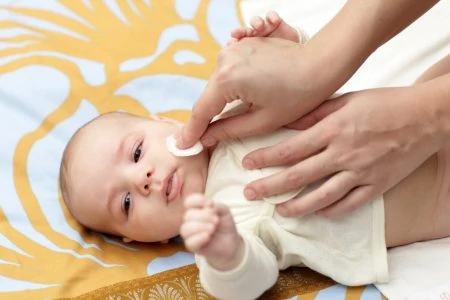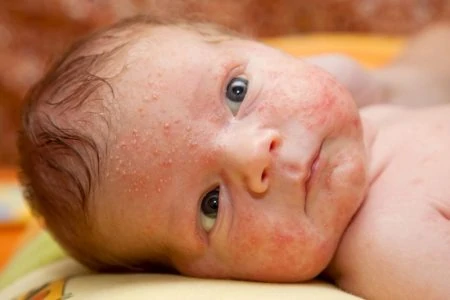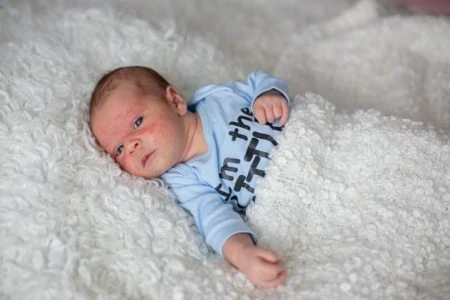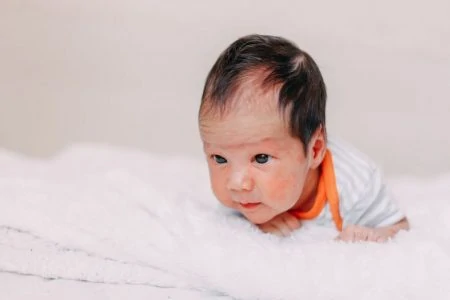Do you have a baby with sensitive skin? You want your little one to be comfortable, but knowing their delicate skin is dry, painful, or irritated can leave you feeling helpless.
Babies may grow out of their sensitivities, or they may not. The important thing is to treat the current symptoms while you work through the underlying cause.
Take back some control by following these sensitive skin tips to ease your little one’s discomfort and your own mind.
Key Takeaways
- Limit baths and use cooler water for babies with sensitive skin, and moisturize with dermatologically approved products after bathing.
- Choose products with natural ingredients, avoiding fragrances and dyes, and opt for those designed for sensitive, dry skin or eczema.
- Use fragrance- and dye-free laundry detergent, avoid air fresheners and candles, and consider natural alternatives for carpet cleaning.
- Select breathable cotton and natural fibers for clothing and bedding, and consider gentle alternatives for diapering and diaper products.
Tips for Babies with Sensitive Skin
1. Less is More
When you first notice that your child has sensitive skin, you might assume you need more of something. Maybe you think more frequent baths will help or heavy-duty lotions. However, this usually aggravates the situation rather than rectifies it (1).
Exposure to water can dramatically increase dryness and encourage continued sensitivity (2). Use cooler water when bathing your baby, as heat can also exacerbate the problem. This is especially true in the presence of eczema.
I recommend bathing infants with eczema every two days, especially during colder winter months when the skin can become drier.
Directly after your baby’s bath, you can use a “locking-in” method to trap moisture in your baby’s damp skin. Use a dermatologically approved (preferably natural) moisturizer for the best results (3).
2. Product Choice is Critical
It’s not enough to just avoid using more of the products you have in rotation. You also need to be highly selective and reconsider the topical products you’re using.
Look for products with all-natural ingredients, without fragrances or dyes, and ones stamped with approval for sensitive skin, dry skin, or eczema.
Many of these conditions are interrelated. What works for one condition will likely work for another; all are formulated to protect vulnerable skin.
Baby aisles are full of sweet-smelling products designed specifically to tempt. But don’t be swayed by beautiful packaging. Trust your intuition — weed out products that may do more harm than good for keeping skin healthy.
The products that I typically recommend for my patients retain moisture longer on the skin, such as Eucerin, Cetaphil, and Aquaphor. I also like Cerave because, unlike other products on the market, it contains ceramides that mimic those that help retain moisture in the skin. The journal Dermatology Research Practice discusses infant skin care in further detail (4).
Editor's Note:
Dr. Leah Alexander, MD, FAAP3. The Importance of Household Products
The significance of product choice doesn’t end with topically applied products. Take a good look at what you use in your home that could contribute to skin issues.
If you aren’t sure where those products might be hiding, start by considering these:
- Laundry: If you aren’t already using fragrance- and dye-free laundry detergent, or one labeled for sensitive skin, choose a brand you trust. Here are some tips from the AAP on how to clean your baby’s clothes (5).
- Optional Laundry Additives: Don’t forget to look at any softeners or dryer sheets you’ve used. Cut them out entirely if you can, and if you just can’t let them go, find ones with no added fragrance.
- Air Additives and Fragrances: Do you have air fresheners around the home? Or perhaps you burn candles? These can both contribute to skin sensitivities.
- Carpet Cleaning Products: Consider swapping commercial carpet cleaners for good old baking soda. It’s excellent at fighting unpleasant odors and contains no harmful chemicals. Make sure you follow your treatment with a thorough vacuuming, as some people have a topical sensitivity to baking soda (6).
Carpet cleaning products can become an issue with infants when they begin to crawl. I have seen several patients with an irritating rash on the legs and knees, only to learn that the family recently cleaned their carpets.Editor's Note:
Dr. Leah Alexander, MD, FAAP
Don’t be afraid to purge, but at the very least, put such products away until the skin problems are under control. Once you feel like you’ve made progress with the compromised skin, reintroduce items one at a time.
If you notice a change or can pinpoint a cause, it’s so much easier to pull it from the rotation and avoid using it in the future.
4. Fibers
Your baby likely spends most of the day in clothing or wrapped in blankets. If your child is experiencing contact irritation, it may be from their clothing or bedding fibers.
When choosing clothes, sheets, or blankets, look for breathable cotton and natural fibers. These are less likely to cause irritation and allow your baby’s skin to have the air exchange it needs.
Some animal products, like wool, can be problematic for sensitive skin. Pay attention to when rashes and skin conditions worsen, and try to learn the potential cause. The more information you can gather, the more likely you’ll be able to avoid the cause in the future.
5. Diapers and Diaper Products
There’s no getting around the need for diapers. If you have a baby, you’re going to need them. But babies with sensitive skin may have frequent diaper rashes.
These aren’t always caused by sitting in a soiled diaper. Sometimes it’s just a contact rash caused by the diaper itself (7).
Keep your little one dry and clean with frequent diaper changes.
Following the “less is more” method, I found I had the best results if I avoided all preventative treatments, such as using Vaseline on a baby’s bottom, unless there was an active skin issue.
Disposable wipes can have harsh soaps that dry out and irritate the skin. If you must use disposable wipes, consider using a gentle formula made specifically for babies with sensitive skin.
Soft flannel reusable wipes and a gentle water and soap mixture (even made with your baby’s favorite bath wash) can provide a great alternative to commercial wipes. If you find the chemicals in disposable diapers exacerbate diaper rash, you may want to consider using cloth diapers instead.
When all else fails, give your baby’s skin some much-needed air time. Let your baby play diaper-free — giving their skin a healthy dose of fresh air can do wonders for any stubborn rashes or other issues. A drying technique that I recommend, especially in fungal diaper rashes, is to dry the diaper area with a blow dryer on the COOL setting for a few seconds. This reduces fungal growth and helps to heal the rash.
6. Adventures with Food
Have you noticed a connection between your child’s skin conditions and the food they’re eating? Are you still exclusively breastfeeding? Is there a pattern regarding your child’s skin conditions and the foods you’re consuming?
If the answer to any of these questions is yes, these are probably not coincidences. Foods can have a visible impact on skin health.
Clinically, I have seen facial rashes around the mouth or cheeks when older infants consume fresh berries or acidic foods such as tomatoes or oranges. This is due to the food’s contact with the skin, not an allergic reaction. Applying an emollient cream as a barrier can protect the skin from irritation while consuming these foods.
Editor's Note:
Dr. Leah Alexander, MD, FAAPIf you believe there’s a connection between diet and skin issues, consider an elimination diet to sort them out. You can also opt to cut something out voluntarily to see what happens.
I found my youngest broke out in a rash across the face whenever I consumed dairy while nursing. It was especially prevalent with cheese. I did my best to cut dairy from my diet, and my baby’s skin reaped the benefit.
Products to Soothe Sensitive Skin Issues
If you’re looking for those perfect products to soothe sensitive skin, here are some I couldn’t live without and can’t recommend highly enough.
1. Garden of Life Organic Cold Pressed Extra Virgin Coconut Oil

Coconut oil has so many uses. You’ve probably seen it recommended for everything, from putting it in your coffee to cleaning your wood furniture.
One thing’s for sure: coconut oil is a go-to product for dry and painful skin. Does your baby have peeling lips, a sore bottom, or chafed legs? A little coconut oil smoothed on after a tepid bath can do wonders for their skin.
Coconut oil has a high melting point. Warm it and apply as you would a traditional baby oil, or rub it into your baby’s skin in its solid state. The heat from the skin will melt the oil, encouraging it to seep in, where it can provide much-needed moisture.
I love that this Garden of Life coconut oil is made with non-GMO and unrefined oil. It will last you up to two years on the shelf — not that mine ever sat around that long.
You may find it works so well for your little one that you want to try it yourself.
In my patients with moderate to severe eczema, coconut oil seems to work the best, even more so than other products that are marketed for this purpose.
Editor's Note:
Dr. Leah Alexander, MD, FAAP2. Burt’s Bees Calming Shampoo and Body Wash

I loved incorporating this body wash into my bedtime bath routine. We didn’t do a bath every night, which helped prevent excessive drying.
The corresponding moisturizer with the same calming scent (naturally derived lavender and vanilla) helped keep our routine regular even when we skipped bathtime.
I really appreciate this product because my fragrance options were so limited because of my baby’s sensitive skin. This one smells so light and sweet and very appropriate for a baby — simply perfect for cuddling to sleep.
If you’re still concerned about bringing home a product not marked “unscented,” take comfort in knowing this is pediatrician-tested and hypoallergenic.
It’s also phthalate-, paraben-, petrolatum-, and synthetic-ingredient-free. It doesn’t get any more natural than this.
Both a solid bedtime routine and lavender can help transition a resistant baby to sleep (8). If you’re looking for a better night’s sleep and a baby with better skin, using Burt’s Bees calming wash is a great start.
Avoid lavender oil and products that contain it due to the potential adverse endocrine effects.
3. Aquaphor Advanced Therapy Healing Ointment
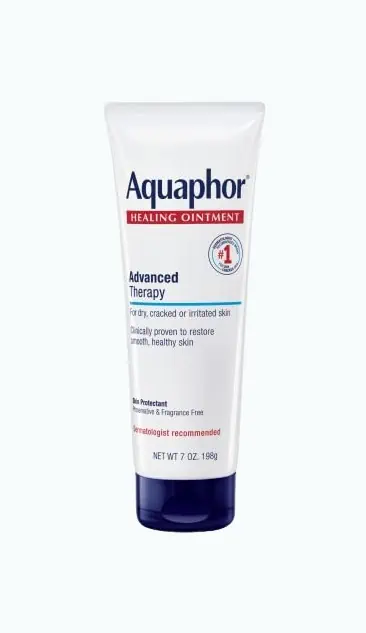
Aquaphor is a popular product, and there’s a reason why. Recommended by dermatologists for dry, cracked, or damaged skin, it allows air exchange to take place and promotes healing.
I used Aquaphor on my baby’s exceptionally dry patches of skin and also on diaper rashes.
However, this is a petroleum-derived product. So you may opt for an alternative if you use cloth diapers.
Or, if you need a heavy dose of Aquaphor for a day or two, you can always switch to disposable diapers temporarily.
If you haven’t used Aquaphor before, be aware that it won’t be absorbed immediately into the skin. It sits on top while the skin slowly absorbs the moisture it needs.
If the feel of the product bothers you, consider using it before bed when your little one will spend less time in your arms.
